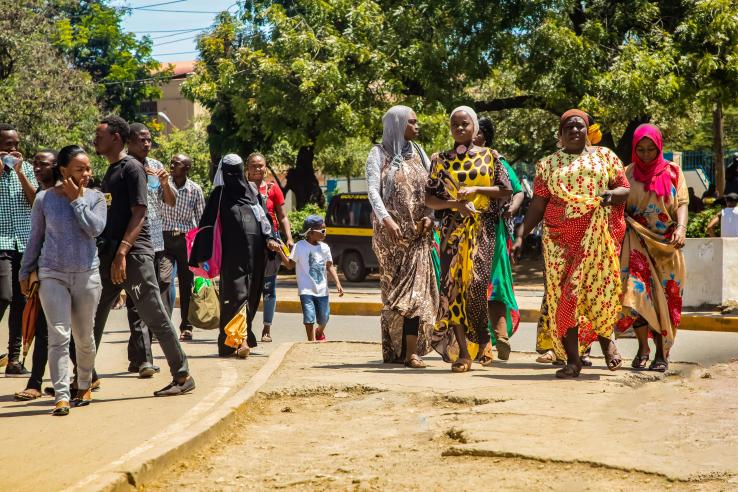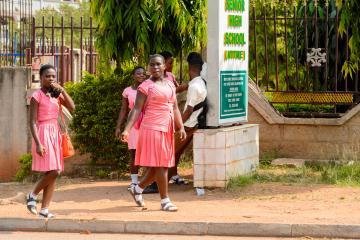
Unpacking the evidence on social programs in sub-Saharan Africa

J-PAL Africa recently concluded a five-part blog series providing evidence-informed perspectives on key debates in the fight against poverty in sub-Saharan Africa. The series was published in collaboration with Debating Ideas, a section of African Arguments, which is a pan-African platform for news, investigation, and opinion.
Posts in the blog series highlight lessons for policymakers on key questions, such as:
- whether universal basic income can help mitigate shocks, such as Covid-19;
- whether digital tools can be used to accurately target social protection programs to people in need;
- if digital identification (ID) can improve service delivery;
- if education subsidies can help bridge the gap in girls’ secondary school attendance; and
- whether changing electricity billing systems can increase energy access for low- and middle-income households.
Universal basic income
When the Covid-19 pandemic pushed an additional 100 million people into extreme poverty in 2020, governments and civil society responded with a large increase in the number and reach of social protection programs, including substantial cash and in-kind transfers. One such type of transfer is a universal basic income (UBI), an unconditional cash transfer delivered to everyone within a community to meet all of their basic needs. The first blog post in the series discusses if a UBI can be a solution to unanticipated shocks, such as Covid-19.
In 2017, J-PAL affiliated professors Abhijit Banerjee, Paul Niehaus, and Tavneet Suri, along with Michael Faye and Alan Krueger, and in collaboration with Innovation for Poverty Action and GiveDirectly, launched a randomized evaluation in Kenya to test the effects of a digitally transferred UBI in two of Kenya’s low-income counties. By 2020, the ongoing study provided a unique opportunity to understand how digital cash transfers can help during a crisis, such as Covid-19. The researchers found that UBI led to modest but significant effects on welfare, decreasing hunger and increasing physical and mental health.
The UBI also provided a safety net that encouraged risk-taking, with more recipients investing in non-agricultural enterprises prior to the pandemic. Although these enterprises largely remained open during Covid-19, the increased risk may have increased exposure to negative shocks. Rather than indicating a failure of UBI—as by design it encourages risk to increase returns while providing a cushion for basic needs—the results show the magnitude of the pandemic and the need for governments to protect incomes. The results demonstrate the need for social protection programs and building infrastructure for cash transfer systems for income support that can be activated at short notice in response to unanticipated crises.
Targeting social protection
During the Covid-19 pandemic, many governments were faced with the challenge of identifying beneficiaries of anti-poverty programs. Some governments were able to test new and innovative approaches, including using easily accessible data to target households. The second blog post in the series looks at whether these innovative methods delivered on their promise of reaching the poorest people.
For example, during the pandemic, the government of Togo, in partnership with Josh Blumenstock et al., used satellite imagery to create poverty maps. These maps were generated by a machine-learning algorithm that estimated wealth using indicators such as metal roofs and the quality of local roads. Similarly, the government of Nigeria combined geolocated household survey data with satellite imagery and other geospatial data to construct high-resolution poverty maps.
The blog highlights that digital methods hold great promise but are not without their pitfalls. Machine learning models do not entirely remove the need for data collection, and easily available data, such as mobile data, may exclude the poorest people. Safeguards are necessary to ensure that targeting methods use data appropriately. While novel data solutions will continue to offer exciting new pathways to improve targeting methods, rigorous research is key for ensuring that social safety nets effectively reach and protect their intended beneficiaries.
Do digital IDs hold real promise in improving service delivery?
As targeted relief programs become more widespread, many governments are testing whether digital ID systems can uniquely identify individuals and assist in generating a cleaner and more precise database to administer relief measures. The third blog post in the series looks at whether digital identification systems can improve service delivery in Africa.
One of the ways digital IDs are being applied is in microcredit. Lenders’ ability to keep costs low depends on repayment from borrowers. Identification is seen as a possible tool to decrease cost, as borrowers can then be consistently tracked over time. In one randomized evaluation, J-PAL affiliates Dean Yang and Jessica Goldberg, together with Xavier Giné from the World Bank, assessed the impact of collecting farmers’ fingerprints on loan repayment. The study found that fingerprinting improved repayment, particularly for borrowers expected to have the poorest repayment performance, and induced the riskiest borrowers to repay their loans at almost the same rate as the least risky borrowers.
Despite promising initial findings of digital IDs, implementation challenges, such as poor data coverage and power outages, can lead to low adoption of these solutions and make them difficult to scale. For effective implementation, it may be important to develop context-specific, low-technology solutions. More rigorous evidence is needed on how to best design these systems and their implications.
Increasing girls’ enrollment in school
Sub-Saharan Africa has the largest population of out-of-school girls. Recognizing the gender gap in education, many governments, donors, and implementing organizations are developing programs to address gender-specific barriers to education. However, poverty remains a key barrier to school enrollment. The fourth blog post in the series discusses if and how poverty reduction mechanisms like cash or in-kind transfers should be used to address the challenge of girls’ enrollment.
Seminal research by J-PAL affiliates Esther Duflo, Pascaline Dupas, and Michael Kremer in Ghana tested whether providing a four-year scholarship to low-income, academically qualified students in senior high school could improve enrollment. The study found that girls who received the scholarship were more likely to enroll and complete senior high school, as well as transition to tertiary. The scholarship also had long-term effects in terms of fertility decline and increased labor participation.
While some may be concerned that transfers are expensive to deliver, an extensive evidence base illustrates how program design details, such as reducing the size of transfers, targeting effectively, and loosening conditionality, may all help make these programs cost-effective.
Electricity billing and energy access
In 2019, only 47 percent of the sub-Saharan African population had access to electricity compared to 90 percent of the global population. Households without electricity rely on kerosene and biomass for fuel, which have potentially harmful health and environmental effects. At the same time, governments struggle to balance the books. It is estimated that unpaid electricity bills amounted to around 0.17 percent of GDP for all nations across the region, causing households to accumulate debt. To address the joint challenge of access and availability, governments across the region have been testing different billing systems. The fifth and final blog post in the series addresses if the transition from post-paid to prepaid energy bills can improve household energy access and availability.
J-PAL affiliate Kelsey Jack and Grant Smith conducted a randomized evaluation in Cape Town, to measure the impact of transitioning to prepaid meters on households and energy utilities. The study found that while the scheme led to better payment recovery, it also reduced household average energy consumption by 14 percent.
If switching to prepaid electricity caused the utilities’ increased revenue from cost recovery to surpass that lost due to lower electricity consumption, governments could potentially use the net revenue gained to improve energy delivery and expand grids to rural communities that face the lowest levels of energy access. However, the true effect on energy access would depend on how the utilities are regulated and what policies are in place to ensure households that previously used postpaid meters can still afford energy.
The role of evidence in evaluating social programs
There are many open questions regarding how to best reduce poverty. Real-world evaluation of social programs is vital for informing these debates and addressing concerns around effectiveness, cost, and impact on local communities. If you are interested in more interesting reflections on the impact of various poverty-reduction schemes, please don’t hesitate to contact our J-PAL Africa team.




